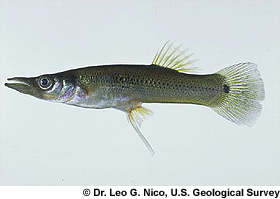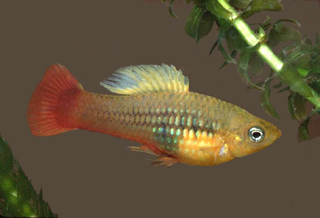Pike Killifish

Belonesox belizanus
These silvery beige fish have very distinct elongated snouts with a lower jaw that is noticeably longer than the upper. Overall, they grow to around 6 inches long, but because of their growth rate and large brood size, and their tolerance to water quality, they thrive in a variety of habitats. An introduced population in South Florida has persisted since the 1950s, the result of a release following a medical research program. Because they are aggressive and sometimes cannibalistic, they are not popular aquarium fish.
Order – Cyprinodontiformes
Family – Poeciliidae
Genus – Belonesox
Species – belizanus
Common Names
Pike killifish (English), pike livebearer (English), pike topminnow (English), topminnow (English), gelber hechtkärpfling (German), hechtkärpfling (German), lebendgebärender hechtkärpfling (German), pepesca gaspar (Spanish), szczupaczek zyworodny (Polish), and zhivorodyaschaya schuchka (Russian).
Importance to Humans
At one time, pike killifish were of importance to medical science as research animals. It is interesting to note that the introduced population in south Florida stems from the release of pike killifish that were the subject of a medical research program whose funding had been terminated. Pike killifish are also of some value to aquarists, but due to their aggressive piscivory and cannibalistic tendencies their potential for wide spread popularity has been limited.
Conservation

This species is not listed as threatened or vulnerable by the World Conservation Union (IUCN). The IUCN is a global union of states, governmental agencies, and non-governmental organizations in a partnership that assesses the conservation status of species.
> Check the status of the pike killifish at the IUCN website.
Geographical Distribution
The native range of the pike killifish extends from the Atlantic slope drainages of Veracruz, Mexico, east through the Yucatan, Belize, Guatemala, Honduras, Nicaragua, and northern Costa Rica. A non-native population of B. belizanus maxillosus in Southern Florida, USA was established in 1957 and persists today.
Habitat

Pike killifish prefer the warm surface waters of slow flowing rivers, ponds, and lakes, particularly those with abundant aquatic vegetation. A common resident of near shore and backwater habitats, the pike killifish is tolerant of low levels of dissolved oxygen. This physiologically labile fish may also be found in brackish water habitats such as lagoons and estuaries as well as marine environments with salinity levels as high as 40ppt.
Biology
Distinctive Features
The long, toothy jaws of the pike killifish, which lend this fish something of a menacing appearance, distinguish this livebearer from all others. In keeping with other livebearers, males possess a readily observable gonopodium, a modified anal ray that serves to facilitate internal fertilization. The pike killifish is not likely to be confused with any other cyprinodontiforms or “killifishes” (a term broadly applied to certain species of both live-bearing and egg-laying Cyprinodontiform fishes).
Coloration
The overall body color of the pike killifish is light beige, darkening dorsally. Many rows of numerous, small black spots are present on the lateral upper half of the fish, with those spots just anterior to the midbody largest and darkest. A large black spot is present at center or slightly above center of the caudal peduncle. Cryptic young possess a dark lateral stripe that presumably aids in their ability to mimic small twigs or plant litter as they float motionless at the surface.
Size, Age & Growth
Obtaining a maximum total length of 150mm, the pike killifish is the largest member of the family Poeciliidae. As a rule, females are larger than males, and growth being rapid, reproductive maturity is typically achieved within 6-12 months. On average, pike killifish are approximately 15 or 16mm at birth. Like most livebearers, pike killifish are likely short-lived.

Food Habits
The pike killifish is a piscivore that in its native habitat feeds largely on other surface or near surface dwelling poeciliids such as the familiar mosquitofishes, swordtails, and platies. Juveniles prey on other juvenile or larval fishes. Pike killifishes of all sizes are reported to engage in cannibalism.
Reproduction
Poeciliids are ovoviviparous; fertilization is achieved internally. Males inseminate females through the use of the gonopodium. The fertilized ova develop within the female, the end result of which is the birth of live young. Given favorable conditions, livebearers living in tropical environments often breed year round and pike killifish are no exception. One laboratory study determined that female pike killifish store sperm and depending on environmental factors produce on average one brood every 38 to 49 days. However, the highest reproductive outputs among these fish tend to coincide with the rising waters brought on by the rainy season.
Pike killifish broods can be quite large with as many as 322 young recorded in a single brood, qualifying the pike killifish for the ranking of second most fecund poeciliid.

Predators
Juveniles and adults alike fall prey to a wide variety of aquatic predators including other predatory fishes, piscivorous reptiles and aquatic invertebrates. As surface dwellers, these fishes are likely very susceptible to predation by wading birds.
Taxonomy
Rudolf Kner, an Austrian ichthyologist whose background included formal training as a physician, described the pike killifish in 1860, erecting a new genus, Belonesox, in recognition of this distinctive fish. Carl L. Hubbs recognized two subspecies of pike killifish in 1936, Belonesox belizanus belizanus and the more robust Belonesox belizanus maxillosus.
Prepared by: Robert H. Robins